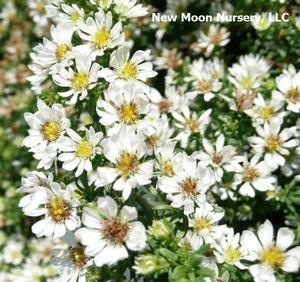New Moon Nurseries
Aster ericoides
heath aster
Native to North America
FIRST IMPRESSIONS: Along with the goldenrods and native grasses, asters are the quintessential herbaceous fall color plants of North America. This one is a compact bushy perennial with pubescent gray-green leaves. Aster ericoides thrives in sun and adapts to most soils. Plants produce billowing white flower panicles in early autumn. The frothy flower display draws the eye and beckons to a bevy of butterflies and other pollinators.
HABITAT & HARDINESS: Aster ericoides is native from Quebec to Manitoba and south from Maine to Alabama and west to North Dakota and Arizona.
Habitats include mesic to dry prairies including Blackland prairies, gravel prairies, dolomite prairies and hill prairies. Plants are also indigenous to savannas, limestone glades, dry rocky woods, pastures and railroad or roadside right-of-ways. This aster occurs in either high quality or disturbed habitats.
Plants are hardy from USDA Zones 3-10.
PLANT DESCRIPTION: Aster ericoides is upright branching rhizomatous perennial.
Plants have linear basal leaves that are up to 3” long and ¼” across. As the pubescent stems rise, the leaf size decreases. Those on the flowering stems are tiny and needlelike giving the plant a heath or heather like appearance.
In early autumn plants are topped by dense sprays of small daisy-like heads. Each is about ½” across with 12 or so white rays surrounding a cluster of golden disc florets.
The heads are borne in profusion and are followed by small seeds with tufts of white hairs that float away on the wind.
Plants grow 1-3’ tall with 1-2’ spread.
CULTURAL & MAINTENANCE NEEDS: Aster ericoides flourishes in sunny sites with medium or dry soils.
Plants tolerate part sun, drought, clay, gravelly or shallow rocky soils and alkaline pH. They are fairly pest resistant but young leaves may be nibbled by deer, livestock or rabbits.
To encourage density, plants can be cut back to 6” in late spring.
This perennial is robust and long lived unless it is shaded or crowded out by taller more aggressive companions. Plants tend to spread from rhizomes to form colonies especially in open disturbed sites.
LANDSCAPE USES: This is a good choice for a Wildlife Garden or Meadow. This aster is also used as a Butterfly Nectar Plant, Butterfly Host Plant, Cut Flower or as part of a Grouping or Mass Planting. Aster ericoides has Showy Blooms and is appropriate for Cottage Gardens, Deer Resistant Plantings, Water-wise Landscapes, Rock Gardens, Low Maintenance Plantings and Perennial Borders.
COMPANION & UNDERSTUDY PLANTS: Try pairing Aster ericoides with Echinacea purpurea, Asclepias tuberosa, Penstemon digitalis, Liatris aspera, Solidago speciosa or Andropogon gerardii.
Aster lateriflorus is a white flowered native aster with similar culture that could substitute in a pinch. Aster ericoides ‘Snow Flurry’ could be a worthy replacement in garden situations.
TRIVIA: Many of the established Latin names of Aster spp. were changed recently due to DNA and genetic research findings. So Aster ericoides is now known as Symphyotrichum ericoides.
Aster ericoides differs from other asters with small white heads because of its shorter narrower leaves. Flowerheads also tend to be smaller in size and have fewer ray florets than many other Aster spp.
Long-tongued bees, short-tongued bees, wasps, flies, butterflies, skippers, moths, beetles and plant bugs. Plants host caterpillars of Silvery Checkerspot Butterflies and several species of moths.
Height:
1-3 ftSpread:
1-2 ftSpacing:
18 inUSDA Hardiness Zone:
3-10Bloom Color:
WhiteAster ericoides Characteristics
Attracts Wildlife
- Butterflies
- Pollinators
Attributes
- Interesting Foliage
- East-Coast Native
- Drought Tolerant
- Cut Flower
- Clay Soil
- Rock Garden
- Naturalizing
Exposure
- Full Sun to Partial Shade
Deer Resistant
- Deer Resistant
Flowering Months
- October
- September
- August
Foliage Color
- Green
Growth Rate
- Medium
Juglans nigra Tolerance (Black Walnut)
- Yes
Salt Tolerance
- Medium
Season of Interest (Foliage)
- Fall
- Summer
- Spring
Soil Moisture Preference
- Moist to Dry
